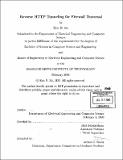Reverse HTTP tunneling for firewall traversal
Author(s)
Sit, Eric N., 1977-
DownloadFull printable version (4.530Mb)
Alternative title
Reverse HyperText Transfer Protocol tunneling for firewall traversal
Other Contributors
Massachusetts Institute of Technology. Dept. of Electrical Engineering and Computer Science.
Advisor
Hari Balakrishnan.
Terms of use
Metadata
Show full item recordAbstract
This thesis describes a reverse hypertext tunneling protocol that allows a web browser from outside a firewall to access a web server inside a firewall. Reverse HTTP utilizes pre-existing proxy services to create a transparent and scalable method to tunnel through a firewall. Reverse HTTP provides an excellent solution to the problem of providing controlled access to firewall protected resources. This is because unlike traditional firewall traversal methods, reverse HTTP is completely software based and requires no changes to the existing firewall configuration. Reverse HTTP works because it tunnels traffic in a form which a web proxy server on the firewall allows to pass. A Java software implementation has been developed and tested to demonstrate the usefulness and efficacy of the reverse HTTP protocol. This experimental implementation proves that a portable, scalable solution can be developed with comparable performance characteristics to a normal web proxy. Although the implementation can be used to view protected web sites, it does not compromise the overall network security.
Description
Thesis (S.B. and M.Eng.)--Massachusetts Institute of Technology, Dept. of Electrical Engineering and Computer Science, 2000. Includes bibliographical references (leaf 104).
Date issued
2000Department
Massachusetts Institute of Technology. Department of Electrical Engineering and Computer SciencePublisher
Massachusetts Institute of Technology
Keywords
Electrical Engineering and Computer Science.